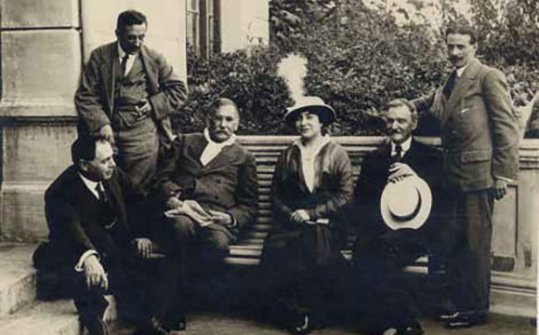Blasco Ibáñez (València, 1867‒Mentón, France, 1928) is one of the most important and most universally hailed Valencian writers. By the end of the nineteenth century, before he had even turned 30, he became extremely popular and had a huge following of fans, who were attracted by his ideas and the volcanic force of his speeches. He instilled in working-class people of the coastal and inland areas an eagerness for knowledge and for learning about developments in all four corners of the world. .
The photographs present Blasco Ibáñez the citizen, writer and tribune and span from his first stays in the Valencian prison of San Gregorio to the return of his mortal remains, accompanied by the highest authorities of the Republic and the fervour of his fellow countrymen. The photographic survey of Blasco Ibáñez is complemented with a selection of excellent portraits of great Spanish writers of his day. Photos from their public and private lives reveal the men and women behind the public personae. For example, they show Emilia Pardo Bazán with her pet cat in the sitting-room of her home on calle Princesa in Madrid, where she entertained members of the city’s social and cultural scene, in 1910; José Echegaray arriving at the Royal Palace for consultation sessions with King Alfonso XIII (around 1905); Benito Pérez Galdós reading printer’s proofs of his inaugural lecture delivered at the Spanish Academy on 6 February 1897; and Joaquín Sorolla painting Jacinto Benavente’s portrait in 1917 in his studio on Paseo del General Martínez Campos, now the Museo Sorolla.
The exhibition shows the relationships between writers and influential figures of the day such as Leopoldo Alas Clarín, Antonio Machado and Federico García Lorca and features the work of the most famous photographers of the period, including Alfonso, Compañy, Franzen, Káulak, Nicolás Muller, and Massip. A highlight of the selection is the several group photographs showing, for example, the literary gathering headed by Manuel Azaña and Valle-Inclán in the room known as the Cacharrería in the Athenaeum in Madrid, which became an active hub of Republican conspiracies during the final period of the monarchy (1930).
One photograph features the editorial team of the magazine España, with Ortega y Gasset, Azorín, Pío Baroja and Pérez de Ayala, among others. Another interesting picture shows Blasco Ibáñez arriving in Argentina in 1910. When his ship pulled into Buenos Aires harbour, a dozen or so reporters hurried onto the deck to take the first photographs of him in the country. The international fame the Valencian writer enjoyed comes across in several of the photographs.
Blasco Ibáñez’s success and popularity knew no frontiers. During a long lecture tour of the United States, he was awarded an honorary degree by the University of Washington.
The exhibition is the result of more than 20 years’ research carried out at dozens of public and private archives, both Spanish and foreign. The photographs featured in the exhibition come from various institutions such as the Biblioteca Nacional de España, the Biblioteca Valenciana, the Archivo Histórico Provincial de Guadalajara, the Pedro Melero collection, Fundación José Ortega y Gasset-Gregorio Marañón, the Instituto del Patrimonio Cultural de España, and the Library of Congress in Washington. The show is an ambitious survey of Spanish portrait photography from its origins to the eve of the Civil War.



